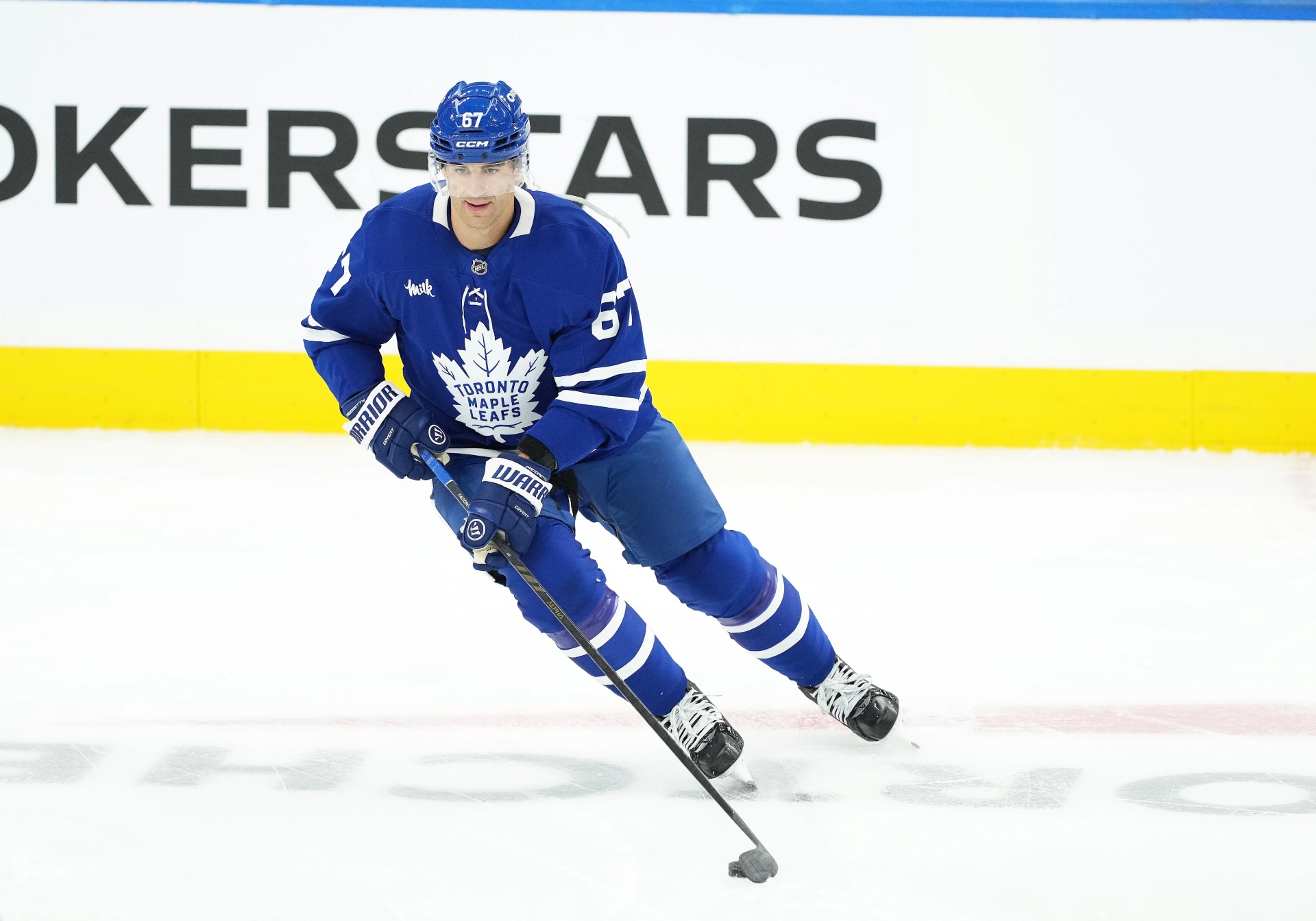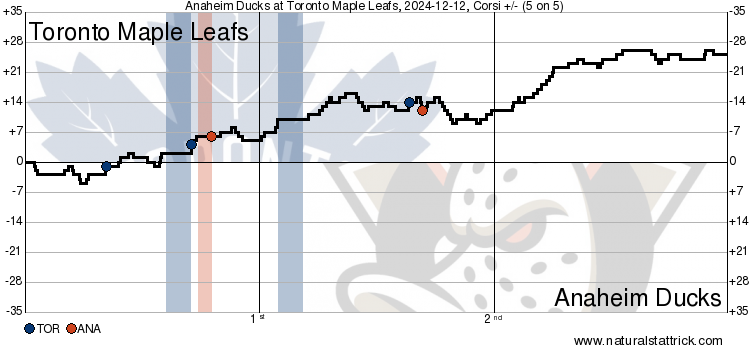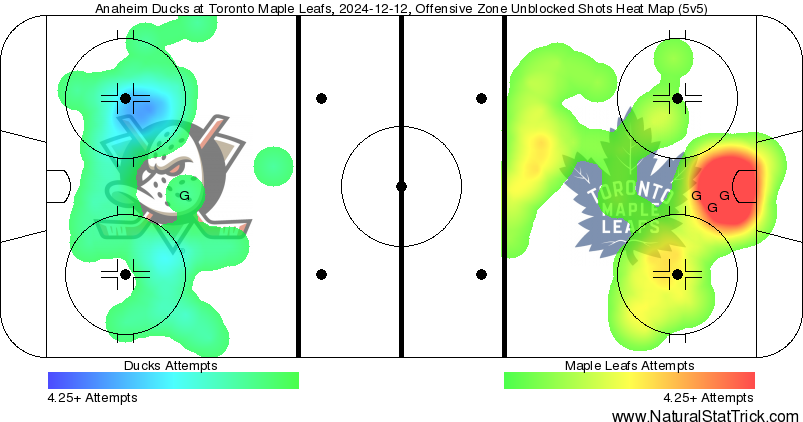It wasn’t completely stress-free — and might have come with a notable injury loss (depending on Anthony Stolarz’s status) — but the Maple Leafs got the job done against the Anaheim Ducks on Thursday night.
The Leafs should’ve scored more than three tonight, but they also allowed two or fewer on home ice for the 12th time in 17 games, a highly impressive statistic.
Your game in 10:
1. No point in burying the lede tonight.
There will be a lot of 20/20 hindsight in the market if this Anthony Stolarz injury is anything more than minor, but I can’t get on board with the second-guessing. If I genuinely believed they were unnecessarily leaning too hard on one of these relatively untested goalies and he got hurt, it’d be one thing. But Stolarz has played 17 games this season (still not even a 50-start pace despite a notable injury to Joseph Woll), and he was asked to play a Friday – Tuesday – Thursday schedule this past week. The injury, if it came on the Frank Vatrano goal (which we don’t know for sure), occurred on a routine play in a relatively quiet period.
What is there to say here besides, “Hope he’s okay?” Stolarz was brought in to roughly split the starts, and he has started at fractionally more than a 50/50-split pace due to the Woll injury. It’s reasonable to ask him to play two games in a row when his hand was red-hot coming out of New Jersey, and he likely relished the opportunity to string a few together (what’s the narrative if Woll starts and has an off-game tonight?). After tonight’s game, Stolarz was guaranteed to play just one game in the next five days due to the Saturday-Sunday back-to-back followed by a two-day break. It’s a non-issue for me from a decision-making process perspective, and hopefully, it’s nothing serious anyway.
2. The Leafs’ start to the game, which we have been monitoring after four underwhelming ones in a row, wasn’t exactly gangbusters. They didn’t tilt the ice right away and conceded the first few shots of the game. Still, they established a foothold in the game and grabbed the lead inside seven minutes.
It is the type of goal that would’ve left Craig Berube smiling on the bench and in the video room later. The initial offensive-zone faceoff situation was created by a good cycle shift from the fourth line, which nearly ended with Ryan Reaves connecting with Jake McCabe for a goal at the top of the crease (Lukas Dostal got a stick on it). Coming out of the TV timeout, it was a well-executed faceoff play where the Leafs’ winger (Max Pacioretty) was quick to the 50-50 puck to help win it, and William Nylander shot across the top of the circle to receive the puck.
The Leafs got multiple bodies to the net front, and McCabe put the puck in a good area from the point. John Tavares was extremely strong on the puck down low — as he often is — and made a skilled play in a tight area — as he often does — before Pacioretty sprawled out to finish it off.
Pacioretty 3rd of the Season vs Ducks courtesy of @Bonsie1951 and @Jim_Ralph. @LeafsJelly pic.twitter.com/MFwcoydL4u
— Maple Leafs Hotstove (@LeafsNews) December 13, 2024
Good details and a hard-earned goal led to the Leafs grabbing the first lead of the game, which, for a team with their elite goaltending and generally solid defensive play, has been almost a guaranteed win this season.
3. We’ve been plenty critical of Pontus Holmberg’s frustrating puck play and lack of finish in this space, but a word of praise here, coming off a big shorthanded goal in New Jersey: He has been a high-motor worker bee for the team this season, and it shows in his penalties drawn. He drew his eighth and ninth penalties of the season tonight, which means he now leads the team (tied with Robertson). He’s drawn a bunch where he’s kept his feet moving in traffic and put defenders in bad spots where they’re reaching in or forced to obstruct. He drew a tripping call off of Radko Gudas that led to the Leafs’ 2-0 goal in the first period and another off of Jacob Trouba early in the second period.
The Leafs’ second power-play unit scored just after the first-period Anaheim penalty expired on a give-and-go rush play between Pacioretty and Nylander. It was effectively a power-play goal as Gudas skated straight to the bench out of the box, waving his stick at Nylander in the neutral zone on the way by.
The big difference in this play over the many entries we’ve seen the Leafs’ PP force to the wall for turnovers: Nylander effectively drew in the defenders first versus tossing it over with the PKer already halfway to the Leafs’ player on the boards. That allowed Pacioretty to take a few strides with it and feed it back into Nylander in front, where he did what Nylander does with excellent hand-eye to bat in a bouncing puck after the initial shot was blocked.
Nylander 18th of the Season vs Ducks courtesy of @Bonsie1951 and @Jim_Ralph. @LeafsJelly pic.twitter.com/NQg19dlmpR
— Maple Leafs Hotstove (@LeafsNews) December 13, 2024
4. After a debatable holding call on Simon Benoit in the offensive zone, the Ducks got one back before the end of the first period on a rare goal that beat Stolarz from the top of the circle despite a clean sightline. Frank Vatrano’s release was a little deceptive, and the shot found a tough spot for the goalie — below the blocker and above the pad into the far corner. That is one Stolarz expects to come up with, though.
More concerning than the power-play goal against were the final two minutes of the period once it was a one-goal game. After the Ducks hit the post on a point shot, the Leafs gave up a breakaway to Mason MacTavish, followed by a 2v1.
The plays stemmed from a senseless gamble up the ice by Morgan Rielly and then a turnover by Rielly at the offensive blue line on the same shift. It was poor situational play/game management that easily could’ve cost them the 2-0 lead before the period was over. The Rielly-OEL pairing also gave up another 2v1 earlier in the period that OEL did well to cut out.
5. Speaking of Rielly, it was something of a minor miracle he didn’t end up with a goal against on his record tonight after a forgettable minus-seven stretch through his previous seven games. Rielly-Myers wasn’t a fit (nor was it expected to be a long-term solution), but I am still not sold on the Rielly-OEL pairing, either.
They’re even in five-on-five goals (9-9) and underwater in the underlying stats despite ample offensive-zone starts. Attackers get behind them a little too frequently, and OEL’s comfort with the puck falls off steeply once on the right (not surprising, as it’s the case for most defensemen); he is usually good for at least one really dangerous turnover per game on his offside. They are not exactly lighting it up offensively at the moment, either as a pairing or individually (though OEL produced a few good offensive moments on the left before McCabe’s return shifted him back over).
The alternative solution isn’t obvious when McCabe-Tanev is ticking along so well and the team is one righty short among their clear best six at this time. I suppose the big question to evaluate over time, then, is whether the Leafs have the right depth/mix to roll their two best defensive defensemen together full-time.
6. The Leafs went to their second power play (second of two total) early in the second period after Holmberg’s second drawn penalty in the first 22 minutes of the game. They unceremoniously moved to 2-for-16 on the power play since Auston Matthews returned from injury as the top unit continued to struggle.
I don’t think the five-forward setup is to blame per se, as it generally appears to slot the players in the optimal positions on the ice relative to their skill sets. It’s flashed some brilliance at times. But there is this overriding feeling watching them right now that it’s not clear who is meant to take charge, and in terms of a plan of attack, they don’t totally know what they’re trying to accomplish or what their go-to plays even are.
It is a subject worthy of a much longer article if this persists, so I’ll leave you with this totally mind-boggling stat: The Toronto Maple Leafs are 6-for-56 on the power play with Matthews in the lineup this season, or 10.7%, which is easily the worst mark in the league.
It’s a 20-game sample, but it’s not like the numbers look much better if we expand it to include the final stretch of the 2023-24 regular season or the 2024 playoffs.
7. The Leafs restored their two-goal lead at five-on-five around the midway point of the game courtesy of the same line that did all the scoring tonight, as Pacioretty applied a nice mid-slot tip on a Conor Timmins shot directly off a Tavares faceoff win.
The Leafs are bottom 10 in tipped shots on net and bottom 10 in deflected shots on net so far this season. These probably aren’t reliably recorded stats, but in terms of the eye test, it doesn’t feel too far off the mark. If generating a higher volume of shots from the points with traffic in front is integral to the Berube offensive system, they’ll need more goals like this to score at a high level this regular season and beyond.
PACIORETTY WITH HIS SECOND OF THE GAME vs Ducks courtesy of @Bonsie1951 and @Jim_Ralph. @LeafsJelly pic.twitter.com/DeNsDR8DRg
— Maple Leafs Hotstove (@LeafsNews) December 13, 2024
8. The Tavares line continued to tilt the ice in the team’s favour on the shift following the goal, but when the top line hopped the boards for an offensive-zone faceoff right afterward (which they won initially), the Leafs gave the goal right back. Lost puck battles in the neutral and defensive zones led to a double-deflection goal for Jackson Lacombe past Joseph Woll.
There were a few segments in the opening 40 minutes of this game where you were thinking, “This is closer/sketchier than it should be against a tired and bad Anaheim team.” One of those came in the final two minutes of the first period when the Leafs nearly surrendered a 2-0 lead, and another came after this 3-2 goal.
The initial few shifts were perfectly fine — both were o-zone shifts by the bottom six, which generally gave the Leafs solid minutes tonight without scoring (or conceding). When the Tavares line (otherwise excellent) returned to the ice, they spent a full minute inside their own zone. Timmins flubbed a clearance at one point, leading to more pressure, but Woll was solid, and the Leafs survived the shift.
That said, with the chances the Leafs had, it could’ve been an insurmountable lead; Nylander easily could’ve scored three or four on his own in this game, firing seven shots on goal and 12 individual shot attempts, including a mittful of grade-As. Matthews fired six shots on goal (10 attempts) and wasn’t at all clinical when one-on-one with the goalie tonight.
9. The most encouraging part of the game to me was the manner in which the team came out for the third period up a goal and how they handled the period in general. Granted, they were playing a tired, bottom-feeding Ducks team. Still, they dominated play for an extended period, hitting a post (off a McCabe bomb) and generating a bunch of good looks (I have no idea how Nylander walked away with just the one goal tonight).
The team played a disciplined game (just one penalty, back in the first period) and conceded only three shots on goal at five-on-five (five in total) in the third period. The only really dodgy moment closing out the game came off another rough Rielly shift where Alex Killorn ended up alone in front, but Woll did enough to disrupt him and keep the puck out.
The Leafs moved to 12-1-0 when scoring first, a league-best mark (.875 winning percentage). Their structure without the puck, great goaltending (even when one left the game), strength in the faceoff circle, and ability to turn to McCabe and Tanev in critical situations all provide sources of comfort in these close-out, one-goal scenarios. Most encouraging tonight, on top of the above factors, is that they possessed the puck for most of the third period while playing with the lead, which meant they finished with over 62% of the shot attempts at five-on-five while leading the game for 53 minutes out of the 60. All of this is said with the caveat that the opponent was the Ducks (who were tired, to boot), but many of the above are encouraging season-long trends.
10. A few final notes:
– Jake McCabe returned to the lineup and led the defense core in TOI (granted, it was just 20:07, as the coaching staff mostly rolled the D over the boards against this Ducks team). He picked up an assist on the 1-0 goal, fired two shots on goal, and ripped a bomb off the bar in the third period. His pairing was on the ice for the lone Ducks goal, but the goal wasn’t really on the D pair. The Leafs largely owned the minutes with those two on the ice, as they primarily drew the Vatrano, Terry, and Strome line. McCabe is a huge part of this team — either their best or second-best defenseman right now, along with Tanev — and he didn’t appear to miss a beat coming off a scary-looking injury. Great news for the club.
– To speak prematurely, Max Domi is quietly driving the third line to improved results through two games. It makes a big difference simply having a player who can carry/hold onto the puck and make some plays in the bottom six (i.e. a fully established top-nine NHLer). I expected a slower ramp-up in his return from injury, but he’s skating well and has been pretty good with the puck. It sounds like Bobby McMann is a real possibility for the weekend games, and it’d be interesting to see what a McMann – Minten – Domi / Holmberg – Dewar – Lorentz bottom six would look like. I’m not sure we’ll get the opportunity with waiver considerations and Reaves’ entrenchment in the lineup (not that Reaves has been a particular problem in these past couple of games, but you get my point).
– 18:32 was a well-deserved season-high for Max Pacioretty, who — when healthy — continues to surpass most reasonable expectations so far, between the overall buy-in into his role, the physical play, the stylistic fit next to Tavares and under Berube, and ultimately, the production (nine points in 16 games, including four goals — which match last season’s 47-game total in Washington — and all of it at even strength). A legitimate five-on-five difference-maker so far on a near-league-minimum salary.











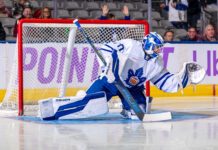

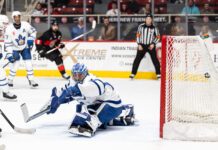

![John Gruden after the Leafs prospects’ 4-1 win over Montreal: “[Vyacheslav Peksa] looked really comfortable in the net… We wouldn’t have won without him” John Gruden, head coach of the Toronto Marlies](https://mapleleafshotstove.com/wp-content/uploads/2025/09/gruden-post-game-sep-14-218x150.jpg)








